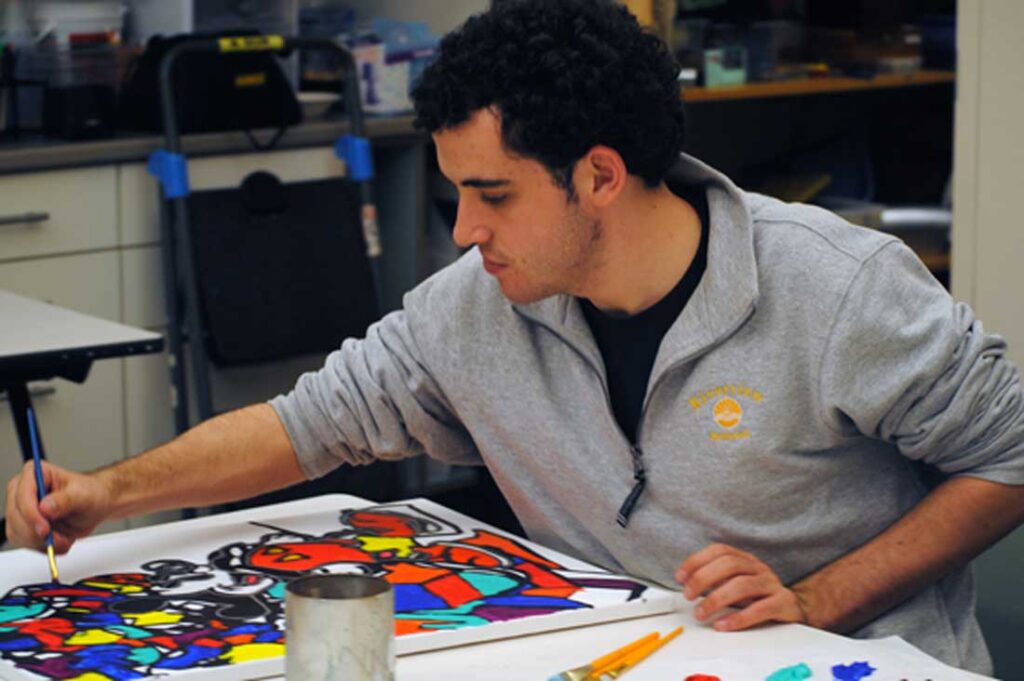During the Night of Too Many Stars autism fundraiser in March 2015, 24-year-old Owen Suskind dressed in gray slacks and a V-neck sweater hurried onstage, clearly excited to meet his idol—and not at all self-conscious about it.
Unlike the celebrities making their way to the microphone for the benefit, Owen did not play it cool. “Hello, Gilbert!” he said, laughing in disbelief as he shook hands with comedian Gilbert Gottfried, who voiced one of Owen’s favorite characters from the animated Disney movie Aladdin. Owen had seen the movie probably 100-plus times since age 3.
Under dozens of lights and cameras, Owen grinned broadly. As Gottfried launched into character as Iago, the evil parrot sidekick to Aladdin’s nemesis Jafar, Owen shook his head incredulously and palmed his forehead in a classic can’t-believe-my-luck gesture before composing himself in preparation for his line. “Patience, Iago, patience,” he intoned perfectly as Jafar. When Gottfried forgot his lines, Owen took over as both characters, and the crowd launched into applause.
Owen’s father, Ron Suskind, was watching from the wings of the theater. More than 21 years earlier, when his precocious toddler suddenly changed, he could not have dared to imagine a moment like this. While an early home video shows Owen standing in his crib and asking his mom to play music from “Mr. Beethoven,” that once-talkative boy was replaced by one who did not return chatter, eye contact or hugs from his older brother, Walt; his mother, Cornelia; or Ron.
Raising a child on the spectrum in the 90s
At that time, there were no televised fundraisers for autism hosted by Jon Stewart, and parenting magazines weren’t loaded with articles about autism spectrum disorder. The Suskind family had only one reference for autism: Rain Man, the 1988 movie starring Dustin Hoffman as an autistic savant who had spent much of his adult life in a mental institution until his long-lost brother, portrayed by Tom Cruise, rescued him. Would this be the Suskinds’ life? Would their son come back? Would he ever talk?
Months later, doctors described Owen as autistic, a diagnosis which would “later… be fine-tuned to ‘regressive autism,’” according to a New York Times article written by Ron. Owen’s future remained unclear.
Being a parent is almost always tiring and scary, but parenting an autistic child can be exhausting and terrifying. Difficulty sleeping is a common symptom of autism, and the Suskinds spent most nights trying to coax Owen back to bed, unsure whether their consoling was more comforting to him or themselves. Unable to express his needs verbally—he spoke only gibberish—Owen was often agitated and angry. His mom spent day after day with him trying out what were, at the time, two of the primary autism therapies—Floortime and the Lovaas Model of Applied Behavior Analysis. These rigorous, labor-intensive methods didn’t seem to make a difference. The couple wondered whether he would ever be able to read, write, have friends, be left alone (he sometimes terrified the family by wandering off) or have a simple conversation.
As Walt hit all the taken-for-granted social milestones of childhood—participating in sports, having sleepovers, going to birthday parties—Owen retreated further into himself, spending almost all of his free time in front of the TV in the basement, which became a literal and symbolic cocoon for him.
Owen Suskind’s love of Disney
In the basement, Owen didn’t just watch TV—he watched Disney movies. The rebirth of the Disney animation brand had just begun with the 1989 release of The Little Mermaid, and the Suskind family had all the videos. Owen played The Little Mermaid, Beauty and the Beast, Aladdin, Snow White and the Seven Dwarfs, Dumbo, Pinocchio and Bambi on repeat. He learned to work the remote control and would rewind and rewatch certain scenes.
If left to his own devices, without his mother dragging him outside for physical, occupational or speech therapy, Owen—more serene and content than at any other times—would spend every minute viewing Disney movies in the basement. Animation became his refuge from the real world, which can be an overwhelming and taxing place for people with autism.
A communication breakthrough
One night as the Suskind family watched The Little Mermaid, Owen kept repeating “juicervose,” indecipherable syllables he had muttered for weeks. Originally the family thought he wanted juice, but he always refused his sippy cup. So they ignored Owen’s babbles and continued to watch.
During the villainous sea witch Ursula’s solo “Poor Unfortunate Souls,” she offers to transform Ariel into a human in exchange for the young mermaid’s enchanting voice. Her pitch ends, “It won’t cost much. Just your voice!”
Owen annoyed the family by rewinding the last stanza several times. On the fourth viewing, Cornelia understood what Owen had been saying. “It’s not juice!” she said, astonished. “It’s voice. ‘Just your voice!’” Cornelia, Ron and Walt grabbed Owen excitedly. “Is that what you’re saying?!” Owen made eye contact with Ron for the first time in a year and repeated, smiling, “Juicervose! Juicervose! Juicervose!”
When Ron wrote about the moment in his book, Life, Animated: A Story of Sidekicks, Heroes, and Autism, he noted, “A mermaid lost her voice in a moment of transformation. So did this silent boy.”
On a separate occasion, Cornelia realized that another example of Owen’s gibberish,
“bootylyzwitten,” was actually the phrase, “beauty lies within” from Beauty and the Beast. Could Owen actually be making these strategic, profound parallels between his life and the animated characters he was watching in the basement?
Despite their skepticism, the family saw these moments as breakthroughs and were euphoric. He was in there. They had proof. Although the afterglow was always short-lived, this proof spurred the family to keep working with Owen—and, most of all, to continue allowing him to indulge in the Disney movies.
How Owen Suskind’s love of Disney led to connection
Many autistic people develop such singular interests, whether it’s with a football team, a rock band, a TV show or an activity such as drawing or stamp-collecting. Historically, in traditional therapies, these obsessions were discouraged—according to Spectrum, “clinicians have historically called them circumscribed interests, and they belong to the category of diagnostic criteria for autism called ‘restricted, repetitive patterns of behavior, interests or activities,’ which also includes movements such as hand-flapping and an insistence on rigid routines.” If he spent all his time watching movies, the thinking was, he’d never learn to interact with the real world. Alternately, the favorite music, movie or hobby was used as a motivation and reward tool: In return for saying hello with eye contact five times in a row, for example, you can watch your video.
But it was Owen’s Disney obsession that led to the one moment of connection the Suskinds had experienced since autism stole his voice. Take those movies from him? No way.
Communicating using Disney characters
By age 5, Owen had regained some words—”car,” “mine,” “hot,” “cold,” “book”—and used them appropriately. But he wasn’t communicating more than basic needs and wants. Ron and Cornelia longed to have a conversation, to know their son’s thoughts and feelings. On Walt’s 9th birthday, when Owen was 6½, Walt cried at the end of his party. Ron and Cornelia assumed he was tired and overwhelmed. But Owen commented, seemingly nonchalantly, “Walter doesn’t want to grow up, like Mowgli or Peter Pan.” It was Owen’s first full sentence since the age of 2.
That night, as Owen was flipping through a Disney picture book on his bed, Ron sneaked into his room and slipped an Iago puppet onto his hand. In his best Gottfried voice—both Ron and Owen do uncanny impressions of the incessantly shouting Gottfried—Ron said, “So, Owen, how ya doin’? I mean, how does it feel to be you?!” Ron recalls that when Owen looked at the puppet, “it was like he was bumping into an old friend.” Then Ron said his son sadly replied, “I’m not happy. I don’t have friends. I can’t understand what people say.” As hard as it was for Ron not to drop the Iago puppet and hug his son, to comfort him as a father, he stayed in character. Their exchange continued. I’m having a conversation with my son for the first time in five years, Ron thought.
Using ‘Disney therapy’ with Owen Suskind
Thus began what the Suskinds originally called Owen’s “Disney therapy,” in which his family—and soon afterward, his therapists and teachers—acted out scenes together, role-played characters and used Disney scenes, themes and situations to help Owen relate to the wider world. Not only did Owen follow and understand the emotional themes of the movies he watched, he was able to apply the meanings to his life and the lives of those around him. As one of Owen’s doctors said, “Autistic kids like Owen are not supposed to [be able to] do that.”
When immersed in the language of his animated films, Owen communicated clearly and comfortably. When the family visited Disney World, Owen spoke less gibberish and his arm-flapping subdued. He was calm, focused and more in tune with his surroundings. Instead of having to constantly adjust to the unfamiliar surroundings of non-autistic folks, the family was finally adjusting to his world. And from there, they could help him navigate the tricky world beyond Disney.
A cycle of hope, success and disappointment
Of course, there’s no Disney-style happy ending in real life, complete with an ensemble song-and-dance number. There are still plenty of challenges for Owen. As Ron reminds himself, “Autism is not a spell that gets lifted—it’s a way of being.”
Bringing up Owen, even with the powerful aides of Iago, Simba, Peter Pan and all his Disney pals, was a cycle of hope, success and disappointment.
When Owen attempted a summer sleep-away art camp, to which he was admitted based on his professional-level Disney drawings, it was disastrous. “The counselors are just kind of overmatched,” the camp director explained when Ron arrived to retrieve Owen early, before the camp ended for the other participants.
But at a Thanksgiving family reunion another year, Owen orchestrated an elaborate play based on James and the Giant Peach with parts for his cousins. He cast himself as the timid, docile Earthworm. He didn’t want to play the hero. When the Earthworm was introduced on the makeshift stage, Owen recited the lines he scripted: “The Earthworm is scared sometimes and confused. And he’s jealous of the Grasshopper [played by his brother, Walt] and the Centipede and characters who can do things that he can’t. And that’s why I’m the Earthworm.” The cousins took their bows to thunderous clapping and tear-filled eyes.
Owen Suskinds’ successes
As of 2015, 32-year-old Owen lives in Hyannis, Massachusetts. In 2017, he and his family were the subject of Life, Animated, an Oscar-nominated documentary. He works at Toys “R” Us, helping customers and pricing merchandise. He also had his Disney-inspired art displayed at Cape Cod’s Rice Gallery in a one-day exhibition. Owen says he embraces himself as a “proud and brave autistic man.”
Owen also helps his parents spread the idea of “affinity therapy,” based on the success of his Disney therapy. “We kept hearing other stories like his from folks on the autistic spectrum,” Ron said. “So many of them find this thing that they’re passionate about, and they pour themselves into it, finding all manner of expertise and ingenuity in how they use it as a source and a framing for identity and for how they see the world. It’s beautiful to see how so many of them use [their affinities] as code-breakers.” He urges people to embrace the interests, however quirky or obsessive they may seem, of their autistic loved ones.
A Pulitzer Prize-winning journalist, Ron wrote Life, Animated about his family’s journey, in part, to share this message. “Loving Owen’s passions is loving who he is. The affinity is more pathway than prison. We have to get on that pathway and walk with him. The more we did that, the deeper he brought us in, and the more we saw of this underlying world and his powerful set of capacities. And now that’s happening for kids all over the world,” he said—they use their affinities to communicate and blossom.
This article was published in October 2015 and has been updated. Photo courtesy of the Suskind family



